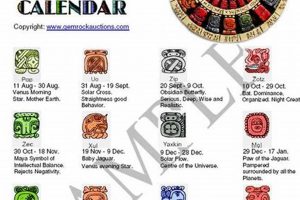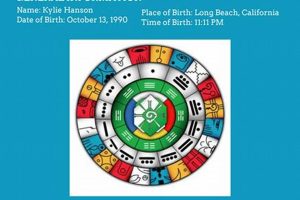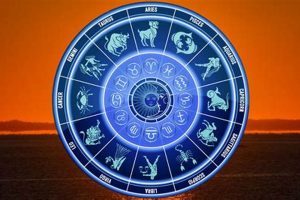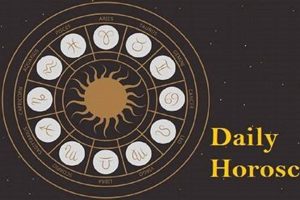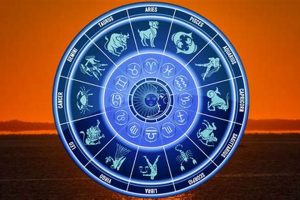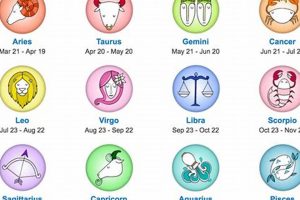A tool designed to determine an individual’s Mayan astrological sign typically requires birth date input. This process parallels Western zodiac calculations but relies on the Mayan calendar system, composed of intricate cycles like the Tzolkin (260-day sacred calendar) and the Haab (365-day solar calendar). A resulting sign, such as Imix or Chicchan, connects a person to specific Mayan day-signs and associated characteristics.
Understanding one’s Mayan sign offers a unique lens for self-discovery. By exploring the symbolism attributed to each sign, individuals can potentially gain insights into their personality traits, strengths, and weaknesses. This practice is rooted in the ancient Mayan civilization’s profound connection to cosmology and the belief that celestial bodies influenced human affairs. This system provides a distinct perspective from other astrological traditions, reflecting the rich cultural heritage of the Maya.
Further exploration of Mayan astrology can involve investigating the meaning of individual day-signs, the interplay between the Tzolkin and Haab calendars, and the role of Mayan deities within this complex system. This intricate astrological tradition provides a fascinating pathway to understanding a unique worldview.
Tips for Utilizing Mayan Astrology Resources
Effective engagement with Mayan astrology involves careful consideration of several factors. The following tips offer guidance for a more informed and meaningful experience.
Tip 1: Understand the Calendar System: Familiarization with the Tzolkin and Haab calendars is crucial. The interplay between these two distinct cycles forms the foundation of Mayan astrological calculations.
Tip 2: Verify Source Credibility: Seek reputable sources rooted in scholarly research or traditional Mayan knowledge. Not all online resources offer accurate interpretations of this complex system.
Tip 3: Explore Beyond the Day-Sign: While the day-sign provides a starting point, delve deeper into its associated symbolism and meaning within Mayan cosmology. Consider its connection to deities and natural elements.
Tip 4: Consider the Entire Birth Chart: Similar to other astrological systems, a complete Mayan birth chart involves more than just the day-sign. Explore the significance of the Lord of the Night and other relevant factors.
Tip 5: Avoid Oversimplification: Mayan astrology possesses significant depth and nuance. Resist reducing its interpretations to simple personality profiles. Embrace the complexity and layered meanings.
Tip 6: Respect Cultural Sensitivity: Approach Mayan astrology with respect for its cultural origins. Avoid treating it as mere entertainment and acknowledge its significance within Mayan traditions.
By following these guidelines, individuals can gain a more profound understanding of their Mayan astrological sign and its potential implications. This approach promotes a more respectful and enriching experience.
Ultimately, exploring Mayan astrology offers a unique opportunity for self-reflection and connection to a rich cultural heritage. Further research and study can deepen this understanding.
1. Mayan Calendar System
The Mayan calendar system forms the foundational structure for calculating Mayan astrological signs. Without a firm grasp of its intricacies, accurate interpretation becomes impossible. This system, unlike the Gregorian calendar, doesn’t simply track linear time. Instead, it interweaves several cyclical calendars, most notably the Tzolkin (260-day sacred calendar) and the Haab (365-day solar calendar). A date in the Mayan system is a combination of positions within both cycles. This interwoven structure is analogous to a complex clockwork mechanism, each gear representing a calendar cycle, and their combined positions determining a precise point in time and consequently, a specific Mayan astrological sign. For example, a birth date corresponding to 8 Ajaw in the Tzolkin and 3 Kumk’u in the Haab yields a unique astrological significance different from other combinations.
The Mayan calendar’s cyclical nature imbues each day with unique energetic qualities, influencing the interpretation of associated astrological signs. This contrasts with Western astrology, which primarily focuses on planetary positions. The interplay between the Tzolkin and Haab calendars creates a 52-year Calendar Round, after which the same combinations of days recur. This cyclical understanding of time informs the Mayan worldview, shaping their astrological interpretations and offering a distinct perspective on individual destinies. For practical application, understanding the Mayan calendar system allows for precise calculation of one’s day-sign and its corresponding meaning within the larger cosmological framework.
In summary, the Mayan calendar system serves as the indispensable engine for calculating and interpreting Mayan astrological signs. Its complex, cyclical nature provides a unique framework for understanding time and destiny. Appreciating this intricate system is crucial for anyone seeking a deeper understanding of Mayan astrology beyond superficial interpretations. Further research into the specific functions and symbolism of the Tzolkin and Haab calendars can illuminate the richness and depth of this ancient system.
2. Tzolkin and Haab Correlation
The correlation between the Tzolkin and Haab calendars forms the backbone of Mayan astrology sign calculators. These two distinct cycles operate concurrently, creating a unique combined date. The Tzolkin, a 260-day sacred calendar, consists of 13 numbered days and 20 named days, cycling through all possible combinations. The Haab, a 365-day solar calendar, comprises 18 months of 20 days each, plus a five-day period known as Wayeb’. A specific date, therefore, is expressed as a combination of a Tzolkin day and a Haab day, such as 8 Ajaw 3 Kumk’u. This combined date serves as the input for the calculator, determining the individual’s Mayan astrological sign. Without this correlation, determining a precise sign within the Mayan system would be impossible.
The significance of this correlation lies in the unique energetic qualities attributed to each combined date. The Tzolkin, often associated with destiny and personal characteristics, intersects with the Haab, linked to the natural world and seasonal cycles. This intersection creates a nuanced understanding of individual characteristics influenced by both cosmic and earthly forces. For example, an individual born on 1 Imix 0 Pop might exhibit different traits compared to someone born on 1 Imix 8 Zip, despite sharing the same Tzolkin day-sign. The Haab date adds another layer of interpretation, enriching the astrological profile. The 52-year Calendar Round, where the Tzolkin and Haab cycles realign, further emphasizes the importance of their correlation, marking significant milestones within a Mayan lifespan.
Understanding the Tzolkin and Haab correlation is paramount for accurate Mayan astrological interpretations. It allows calculators to move beyond simple day-sign identification and delve into the rich interplay between these two calendars. This understanding provides valuable insights into the complex relationship between individual destinies and the cyclical nature of time within the Mayan worldview. Further exploration of specific Tzolkin and Haab combinations can reveal a deeper understanding of the nuances within Mayan astrology, enhancing its practical application for self-discovery and cultural appreciation.
3. Birth Date Input
Birth date input serves as the crucial initial step in utilizing a Mayan astrology sign calculator. This input, unlike in Western astrology which solely relies on the Gregorian calendar, requires consideration of both the Tzolkin and Haab calendar systems. Accurate date entry is paramount for determining the correct correlation between these two cycles and subsequently revealing the individual’s Mayan day-sign. This process initiates the calculation and forms the basis for further astrological interpretation.
- Gregorian to Mayan Date Conversion
The process begins with converting a Gregorian birth date (e.g., June 15, 1990) into its corresponding Mayan date. This conversion is not a simple one-to-one mapping but requires specialized algorithms or conversion tools. Understanding the structure of both the Tzolkin and Haab calendars is essential for accurate conversion and ensuring proper alignment within the Mayan system. Inaccurate conversion can lead to an incorrect day-sign and subsequent misinterpretations.
- Tzolkin Day Calculation
Once the Gregorian date is converted, the corresponding Tzolkin day is determined. This involves calculating the position within the 260-day cycle, resulting in a numbered day (1-13) and a named day (one of the 20 day-signs like Imix, Ik’, Ak’bal, etc.). This Tzolkin day forms a core component of the Mayan astrological profile, representing inherent energies and characteristics.
- Haab Day Calculation
Simultaneously, the Haab day is calculated based on the Gregorian date conversion. This places the birth date within the 365-day solar calendar, consisting of 18 months of 20 days and the five-day Wayeb’ period. The Haab day provides additional context to the Tzolkin day, connecting the individual to the cycles of nature and the solar year.
- Combined Date Significance
The combination of the calculated Tzolkin and Haab days provides the complete Mayan birth date. This combined date, not just the Tzolkin day-sign in isolation, holds significance within Mayan astrology. The Haab day adds a nuanced layer of interpretation, influencing the expression of the Tzolkin day-sign. This emphasizes the interconnectedness of these two calendars and the necessity of accurate birth date input.
Accurate birth date input is fundamental to the entire process of Mayan astrological calculation. It establishes the foundation upon which the individual’s Mayan sign and subsequent interpretations are based. Without precise conversion and calculation of both Tzolkin and Haab components, the resulting astrological profile lacks integrity. Therefore, meticulous attention to birth date input is crucial for a meaningful and accurate exploration of Mayan astrology.
4. Day-sign Determination
Day-sign determination represents a pivotal function of the Mayan astrology sign calculator. The calculator’s core purpose is to identify an individual’s day-sign based on their birth date. This process hinges on the accurate conversion of a Gregorian calendar date into its corresponding Mayan date, expressed through the interwoven Tzolkin and Haab calendar cycles. The resulting combined date reveals the day-sign, one of 20 unique symbols within the Tzolkin calendar, each imbued with specific symbolic meanings. For instance, a birth date corresponding to 1 Imix in the Tzolkin designates Imix as the individual’s day-sign, associating them with primal creative energy and new beginnings according to Mayan cosmology. This determination acts as the cornerstone for further astrological interpretation.
The significance of day-sign determination lies in its role as the primary lens through which individual characteristics are understood within Mayan astrology. Each day-sign embodies a distinct set of attributes, influencing personality traits, strengths, weaknesses, and life path. Accurate determination of the day-sign, therefore, provides a framework for self-discovery and understanding one’s place within the cosmos. Consider two individuals born on different Gregorian dates that resolve to different Tzolkin days. One individual might be born on a day corresponding to 8 Kan, associated with abundance and growth, while another’s birth date might align with 9 Chicchan, related to life force and interconnectedness. These distinct day-signs offer unique insights into their respective natures. The calculator facilitates this process by accurately processing birth date information and pinpointing the corresponding day-sign within the complex interplay of the Tzolkin and Haab calendars.
In summary, day-sign determination is not merely a computational step but serves as the foundational element of Mayan astrological interpretation. It unlocks a symbolic language through which individuals can explore their inherent nature and potential life path. The accuracy of this determination directly impacts the validity and depth of subsequent astrological analysis. Understanding the process and its significance empowers individuals to engage with Mayan astrology in a more meaningful and insightful manner, moving beyond superficial interpretations towards a richer understanding of this complex and fascinating system.
5. Symbolic Interpretation
Symbolic interpretation forms the core of understanding output from a Mayan astrology sign calculator. The calculator provides the raw datathe Mayan day-sign and its corresponding position within the Tzolkin and Haab calendars. However, this data alone holds limited value without the interpretive lens of Mayan cosmology. Symbolic interpretation bridges this gap, translating calculated data into meaningful insights into personality, life path, and spiritual connection. It provides the framework for understanding the significance of one’s Mayan sign within a broader cultural and spiritual context.
- Day-Sign Meanings
Each of the 20 Tzolkin day-signs carries inherent symbolic meanings derived from Mayan mythology and cosmology. Imix, for example, symbolizes creation, while Chicchan represents life force and interconnectedness. These meanings are not fixed dictates but rather archetypal energies that manifest differently in each individual. Understanding these core meanings provides the foundation for interpreting a specific day-sign’s influence. For instance, an individual with Imix as their day-sign might exhibit strong creative potential and a pioneering spirit.
- Tzolkin and Haab Interplay
The combined influence of the Tzolkin and Haab day adds another layer of symbolic interpretation. The Haab day, associated with the solar year and natural cycles, modifies the expression of the Tzolkin day-sign. Someone born on 1 Imix 0 Pop might experience the creative energy of Imix differently than someone born on 1 Imix 8 Zip. The Haab position contextualizes the day-sign, adding depth and nuance to its interpretation. This interplay emphasizes the holistic nature of Mayan astrology.
- Deities and Energies
Mayan astrology associates each day-sign with specific deities and their corresponding energies. Understanding these associations provides further symbolic depth. For example, the day-sign Ahau is connected to the sun god Kinich Ahau, imbuing it with qualities of leadership and enlightenment. Recognizing these divine connections adds a spiritual dimension to the interpretation of one’s Mayan sign, linking it to the pantheon of Mayan deities and their influence on human affairs.
- Numbers and Cycles
The numbers associated with the Tzolkin day (1-13) also hold symbolic weight. These numbers represent different energetic vibrations, influencing the expression of the day-sign. The number 1, for example, represents new beginnings, while 13 signifies transformation. Furthermore, the cyclical nature of the Mayan calendar system introduces concepts like the Calendar Round and longer cycles, impacting the interpretation of individual signs within a larger timeframe. These numerical and cyclical influences provide a dynamic perspective on the individual’s journey through life.
Symbolic interpretation transforms the raw output of a Mayan astrology sign calculator into a rich tapestry of meaning. It unveils the intricate connections between day-signs, deities, numbers, and cycles, providing a framework for self-discovery and understanding one’s place within the Mayan cosmos. By engaging with these symbolic layers, individuals can move beyond simple definitions and delve into the profound depths of Mayan astrology, gaining a more nuanced and insightful perspective on themselves and their connection to the universe.
6. Cultural Understanding
Cultural understanding plays a vital role in interpreting output from a Mayan astrology sign calculator. The calculator itself provides data based on mathematical calculations related to the Mayan calendar system. However, without cultural context, this data remains devoid of its rich symbolic meaning. Appreciating the cultural backdrop of Mayan cosmology, beliefs, and traditions is essential for moving beyond superficial interpretations and gaining a deeper understanding of one’s Mayan sign. This understanding allows for a more nuanced and respectful engagement with this complex astrological system.
- Cosmology and Worldview
Mayan cosmology, with its emphasis on cyclical time, interconnectedness, and the influence of deities, provides the framework for understanding the significance of day-signs. The Mayan worldview, deeply rooted in the natural world and the cosmos, shapes the interpretations of individual signs and their influence on personality and destiny. For example, the concept of Wayeb’, the five-day period at the end of the Haab year, holds specific cultural significance related to transition and reflection, influencing the interpretation of individuals born during this time. Without understanding this cosmological context, the meaning of the day-sign remains incomplete.
- Deities and their Roles
The Mayan pantheon of deities plays a central role in their astrological system. Each day-sign is associated with specific deities and their corresponding energies. Understanding the roles and characteristics of these deities, such as Itzamn, the creator god, or Ixchel, the goddess of weaving and medicine, enriches the interpretation of associated day-signs. For example, an individual born under a day-sign connected to Chaac, the rain god, might be interpreted as having a nurturing and life-giving nature. Cultural understanding of these deities adds depth and complexity to astrological interpretations.
- Rituals and Practices
Traditional Mayan rituals and practices offer further insights into the significance of astrological signs. Ancient Mayan ceremonies often involved invoking specific deities associated with day-signs, seeking their guidance and blessings. Understanding these rituals and their connection to astrological beliefs provides a practical context for the calculator’s output. For instance, knowledge of Mayan birth ceremonies and their focus on connecting newborns to their day-sign deities can illuminate the perceived importance of astrological influence in an individual’s life.
- Respectful Engagement
Cultural understanding fosters respect for the Mayan astrological tradition. It discourages the appropriation or trivialization of a complex belief system. Engaging with Mayan astrology requires sensitivity to its cultural origins and avoiding its reduction to mere entertainment or simplistic personality profiles. Respectful engagement honors the depth and richness of this ancient tradition. This involves acknowledging the lived experience of Mayan communities and recognizing the ongoing evolution of their cultural practices.
Cultural understanding serves as the bridge between the raw data provided by a Mayan astrology sign calculator and its meaningful interpretation. By acknowledging the intricate connections between cosmology, deities, rituals, and worldview, individuals can engage with Mayan astrology in a respectful and insightful manner. This approach enriches the process of self-discovery and fosters a deeper appreciation for the cultural heritage of the Mayan civilization. Further exploration of Mayan history, art, and literature can enhance this understanding and provide a more nuanced perspective on the complexities of their astrological system.
Frequently Asked Questions
This section addresses common inquiries regarding Mayan astrological sign calculations and interpretations.
Question 1: How does the Mayan calendar system differ from the Gregorian calendar?
The Gregorian calendar follows a linear 365-day year, while the Mayan system uses interconnected cyclical calendars, primarily the 260-day Tzolkin and the 365-day Haab. This cyclical structure influences interpretations of time and destiny within Mayan astrology.
Question 2: What is the significance of the Tzolkin and Haab correlation in determining one’s Mayan sign?
The correlation between the Tzolkin and Haab calendars pinpoints a precise location within both cycles, resulting in a unique combined date that determines an individual’s day-sign and its nuanced interpretation. The interplay between these two calendars adds depth and complexity to Mayan astrological readings.
Question 3: Can one rely solely on online calculators for accurate Mayan astrological interpretations?
While online calculators can provide the initial calculation of one’s Mayan day-sign, relying solely on automated interpretations can be misleading. Consult reputable sources and consider the cultural context for a more comprehensive understanding.
Question 4: How do Mayan day-signs differ from Western zodiac signs?
Mayan day-signs, derived from the Tzolkin calendar, focus on energetic qualities and connections to Mayan deities. Western zodiac signs, based on the sun’s position relative to constellations, emphasize personality traits and archetypes. These systems offer distinct perspectives on individual characteristics and destinies.
Question 5: Is there a connection between Mayan astrology and other Mesoamerican belief systems?
Mayan astrology shares some common threads with other Mesoamerican belief systems, reflecting a broader regional interest in cyclical time and the influence of celestial bodies. However, Mayan astrology possesses unique characteristics related to its specific calendar system and pantheon of deities.
Question 6: How can one deepen their understanding of Mayan astrology beyond basic day-sign interpretations?
Further exploration of Mayan cosmology, mythology, and rituals provides a richer context for understanding the nuances of day-signs and their significance. Consulting scholarly resources and engaging with Mayan cultural perspectives can deepen one’s appreciation of this complex astrological tradition.
These frequently asked questions offer a starting point for understanding the complexities of Mayan astrology. Further research and exploration can enrich this understanding and promote a more nuanced appreciation of this fascinating system.
For further exploration of Mayan astrology, consider researching specific day-sign meanings, the intricacies of the Tzolkin and Haab calendars, and the role of Mayan deities within this rich cosmological framework.
Conclusion
Exploration of the Mayan astrological sign calculator reveals a complex system rooted in the intricate Mayan calendar and cosmology. Accurate calculation relies on precise Gregorian date conversion to corresponding Tzolkin and Haab calendar positions. Resulting day-signs offer insights into individual characteristics and potential life paths when interpreted through the lens of Mayan cultural understanding. This interpretive process requires consideration of symbolic meanings associated with day-signs, deities, numbers, and the interplay between calendar cycles. Responsible engagement with this system necessitates acknowledging its cultural significance and avoiding superficial interpretations.
The Mayan astrological sign calculator serves as a gateway to a rich and complex system of belief. Further research and exploration offer opportunities for deeper understanding of this ancient tradition and its enduring relevance. Continued study of Mayan cosmology, mythology, and cultural practices can illuminate the intricate connections between individual destinies and the cyclical nature of time within the Mayan worldview.


